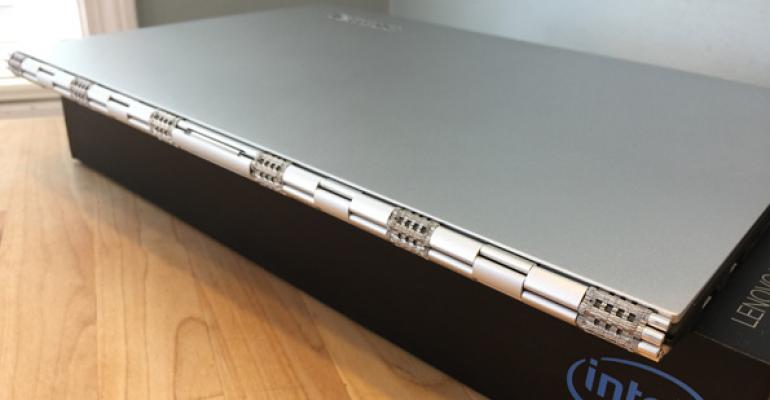When I reviewed the stylish and innovative Yoga 2 Pro in the spring, I described it as the best transforming PC available, and a versatile companion for those on the go. And now its successor, the Yoga 3 Pro is available, offering a fanless and silent Ultrabook experience with some interesting if controversial styling touches.
It will be some weeks before I know for sure whether the Yoga 3 Pro surpasses its vaunted predecessor which, alongside the ThinkPad X1 Carbon, provided Lenovo with an unbeatable 1-2 punch in premium portable PCs. But it's a new season, and there are new competitors like the Surface Pro 3 to consider. So the task before us now is to determine how well the Yoga 3 Pro compares with both the present and the past.

And it has some big shoes to fill. That it is doing so with what appears to be the tech equivalent of Cinderella's glass slipper—a very odd watchband-like hinge that actually glitters under light—is both controversial and exhilarating. I'll see whether this design grows on me—right now, I wish you could get the Yoga 3 Pro without it—but kudos to the normally staid Lenovo for even taking this chance. It's a bold design choice no matter how you feel about it.

Getting past the exterior—and don't worry, the Yoga 3 Pro is indeed available in that same vibrant tangerine as its predecessor, though the review unit is a more pedestrian gray (that, frankly, looks more natural with that hinge)—we should spend some time on what I think is the most important part of this story: The processor. The Yoga 3 Pro is my very first experience with an Intel Core M processor, and yes, while I want this to be special, don't be surprised if it's ultimately disappointing.
Here's the story.
The Core M processor is a Broadwell-class chip that differs from its stablemates in important ways. It's built on a 14 nm process, and aimed at mobile devices. This means it's more efficient, from battery life, power management and heat perspectives, enabling—in theory—PCs that are fanless and silent, and thinner and lighter than ever. The worry of course is that this kind of chip—which is thematically but not technically like using a hybrid engine in a car—will sacrifice performance for this efficiency and the nicety of silence.
Early reviews of the Yoga 3 Pro—most of which were, of course, superficial overviews conducted with virtually no real-world usage—suggest that it's even worse than that, however, that the device is gutless from a performance perspective and gets terrible battery life. This would be inexcusable if true, so I'll be looking out for that. At the premium price points the Yoga 3 Pro commands, no regression in performance or battery life is acceptable.
So that's what we have. A continuation of the versatile Yoga design—remember, this is basically a "4-in-1" PC with laptop, tent, tablet and stand form factor choices—with a controversial watchband-like hinge design and what is apparently now an equally controversial Core M processor. Sounds like I have some fun ahead of me then. I'll start using it immediately.
In the meantime, here are some observations about the review unit specs.
Processor. 1.10GHz Intel Core M 5Y70 with Intel HD Graphics 5300
RAM. 8 GB
Storage. 512 GB SSD, which seems like overkill. There are 256 GB versions of course.
Display. 13.3-inch QHD+ (3200 x 1800) LED glossy multi-touch with 10 touch points. This resolution means you can effectively achieve 1600 x 900 via scaling, which should be rock solid. (For some reason the display scaling was set to 250 percent, however. I changed it to a more acceptable 200 percent.) I will note that the bezel on the screen is enormous, especially on the bottom: Lenovo could easily fit at 14-inch screen in there. And should.
Keyboard. The backlit keyboard initially seemed small to me, so I checked it against a few other portable keyboards. It's the same width as the Surface Pro 3 Type Cover keyboard, which I find a bit cramped. But it's almost exactly the same size as the MacBook Air 13 keyboard, which is wonderful. So it must just be the very wide deck—which is nicely dimpled and grippy—that makes it look small. I will test that, of course. There's a mid-sized trackpad but no nubbin (which I'd prefer).

Size/weight. The Yoga 3 is 13 x 9 x 0.5 inches, which is quite svelte, but the important bit is the weight, 2.6 pounds, which is quite a bit lower than the 3 pounds of its predecessor. This is one light machine.

Battery. Lenovo rates the Yoga 3 Pro at 7.2 hours of battery life and, again, I'll test that. But you'd think a Core M could do better than that.

Expansion. Two USB 3.0, one combo DC-in/USB 2.0 (interesting, that), a 4-in-1 card reader (SD, MMC, SDXC, SDHC), micro-HDMI out, and audio in/out combo jack.

Connectivity. Wi-Fi A/C, Bluetooth 4.0
More soon. I'm still in the market for a new daily driver, and while I'm worried about the low clock speed of the Core M processor and the early reviews, I'll be sure to get to the heart of the matter. This looks like it could be a contender.





